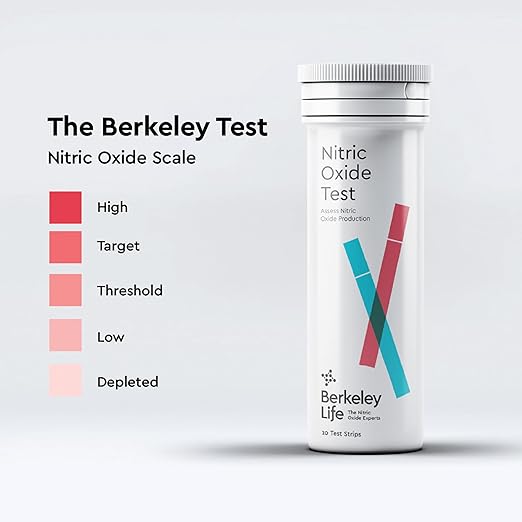
Understanding Nitric Oxide Test Strips: A Quick Guide
Nitric oxide (NO) is a crucial molecule for maintaining optimal health, playing multifaceted roles in cardiovascular function, immune regulation, and overall well-being. Ascertaining NO levels in the body holds significant value, empowering individuals to make informed decisions about their health and lifestyle choices. In this guide, we dig into the nitric oxide test strips, offering insights into their functionality and the benefits they offer.
What is Nitric Oxide?
Nitric oxide, synthesized by various cells within the body, serves as a cornerstone of cardiovascular health. It orchestrates vasodilation, regulates blood pressure, and influences muscle energy utilization. Despite its physiological significance, aging and lifestyle factors like poor dietary habits and sedentary behavior can compromise the body’s nitric oxide production, underscoring the importance of monitoring NO levels.
How do Nitric Oxide Test Strips Work?
Nitric oxide test strips operate by assessing the levels of nitrate and nitrite in saliva. Dietary nitrates undergo conversion into nitrites within the body, eventually culminating in nitric oxide production. Utilizing these test strips involves a straightforward process wherein saliva is applied to the strip, inducing a color change reflective of nitrate levels. This indirect measurement offers insights into the body’s nitric oxide production status.
The Benefits of Measuring Nitric Oxide Levels

Some of the benefits include:
Monitoring Dietary Efficacy
Diet plays a pivotal role in enhancing nitric oxide production. Consuming nitrate-rich foods such as beets, spinach, and arugula not only supports NO synthesis but also contributes to its bioavailability.
Understanding the impact of your dietary choices on nitric oxide status becomes simpler with nitric oxide indicator strips. These strips can provide immediate feedback on the salivary nitrite levels, a direct result of dietary nitrate intake. This instant insight allows for real-time adjustments to ensure your diet effectively boosts NO production.
Optimizing Workout Performance
Nitric oxide is crucial for oxygen delivery during exercise, enhancing blood flow to muscles and improving workout efficiency. Athletes can use nitric oxide indicator strip readings to refine their nutrition and supplementation, targeting an increase in salivary nitrite and, consequently, NO levels.
This strategy ensures that every nitrate-rich meal contributes to better performance and expedited recovery, leveraging the natural process where oral bacteria convert dietary nitrates into beneficial nitrates.
Early Detection of Potential Health Issues
Persistently low NO levels can indicate potential health concerns, such as endothelial dysfunction, which can elevate diastolic blood pressure.
Regular use of NO testing, including nitric oxide indicator strips, can act as an early detection tool. This proactive approach allows individuals to consult healthcare providers early, potentially preventing more severe conditions.
Strategies to Boost Nitric Oxide Levels
Incorporate Nitrate-Rich Foods: Emphasize nitrate-rich foods in your diet to naturally enhance NO production. These include leafy greens, beets, and other vegetables that support salivary nitrite concentrations.
Mind Your Oral Health: Avoid antibacterial mouthwash that can disrupt the oral microbiome essential for converting inorganic nitrate to nitrite, a precursor for NO production.
Regular Exercise: Maintain an active lifestyle to stimulate nitric oxide production and improve overall blood flow.
Monitor NO Levels: Utilize nitric oxide indicator strips to regularly check your NO levels, ensuring that your dietary and lifestyle strategies are effectively boosting your nitric oxide bioavailability.
In Practice: A study highlighted that individuals consuming a diet high in nitrates saw a significant improvement in nitric oxide production and diastolic blood pressure regulation, underscoring the critical role of the oral microbiome in NO synthesis.
By leveraging dietary interventions, maintaining oral health, and regularly monitoring nitric oxide status, individuals can harness the power of NO to improve fitness results, enhance health, and prevent potential issues before they arise.
How to Use Nitric Oxide Test Strips
Ensure Optimal Testing Conditions: Abstain from consuming anything except water for a minimum of 2 hours prior to the test to mitigate potential interference with results.
Collect Saliva: Place the test strip on your tongue or in a spoonful of saliva for the duration specified by the manufacturer, typically a few seconds.
Interpret Results: Upon completion, compare the color change of the strip to the provided chart to ascertain your nitric oxide level.
Take Action: Based on the results obtained, consider adjusting your dietary, exercise, or supplementation regimen accordingly, or seek guidance from a healthcare professional.
Conclusion
Nitric oxide test strips are crucial tools for anyone looking to boost their health and fitness. They provide immediate insights into NO levels by analyzing samples from the oral cavity, directly involving the salivary glands in the process. This real-time feedback enables individuals to make educated choices about their diet, workout plans, and broader lifestyle changes.
There’s a significant positive correlation between the use of these strips and the ability to fine-tune health strategies for optimal results. Nonetheless, incorporating nitric oxide test strip readings into a well-rounded health regimen—underpinned by expert medical advice—is vital for achieving and maintaining peak wellness.
References
Bryan, N. S., Ivy, J. L., & Marzocca, A. (2010). The effect of nitric-oxide-related supplements on human performance. Sports Medicine, 40(11), 1015-1035. DOI: 10.2165/11536900-000000000-00000
Lundberg, J. O., & Weitzberg, E. (2010). Nitric oxide production in the human nasal cavities. The Journal of Physiology, 588(17), 2905-2907. DOI: 10.1113/jphysiol.2010.193318
Ormesher, L., Myers, J. E., Chmiel, C., Wareing, M., Greenwood, S. L., & Tropea, T. (2018). Effect of peroxynitrite on relaxation of the human placental vasculature in vitro. Nitric Oxide, 81, 12-18. DOI: 10.1016/j.niox.2018.09.002
